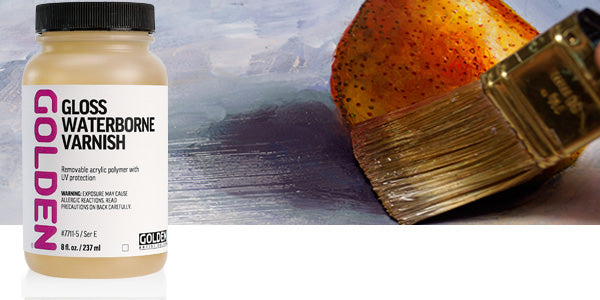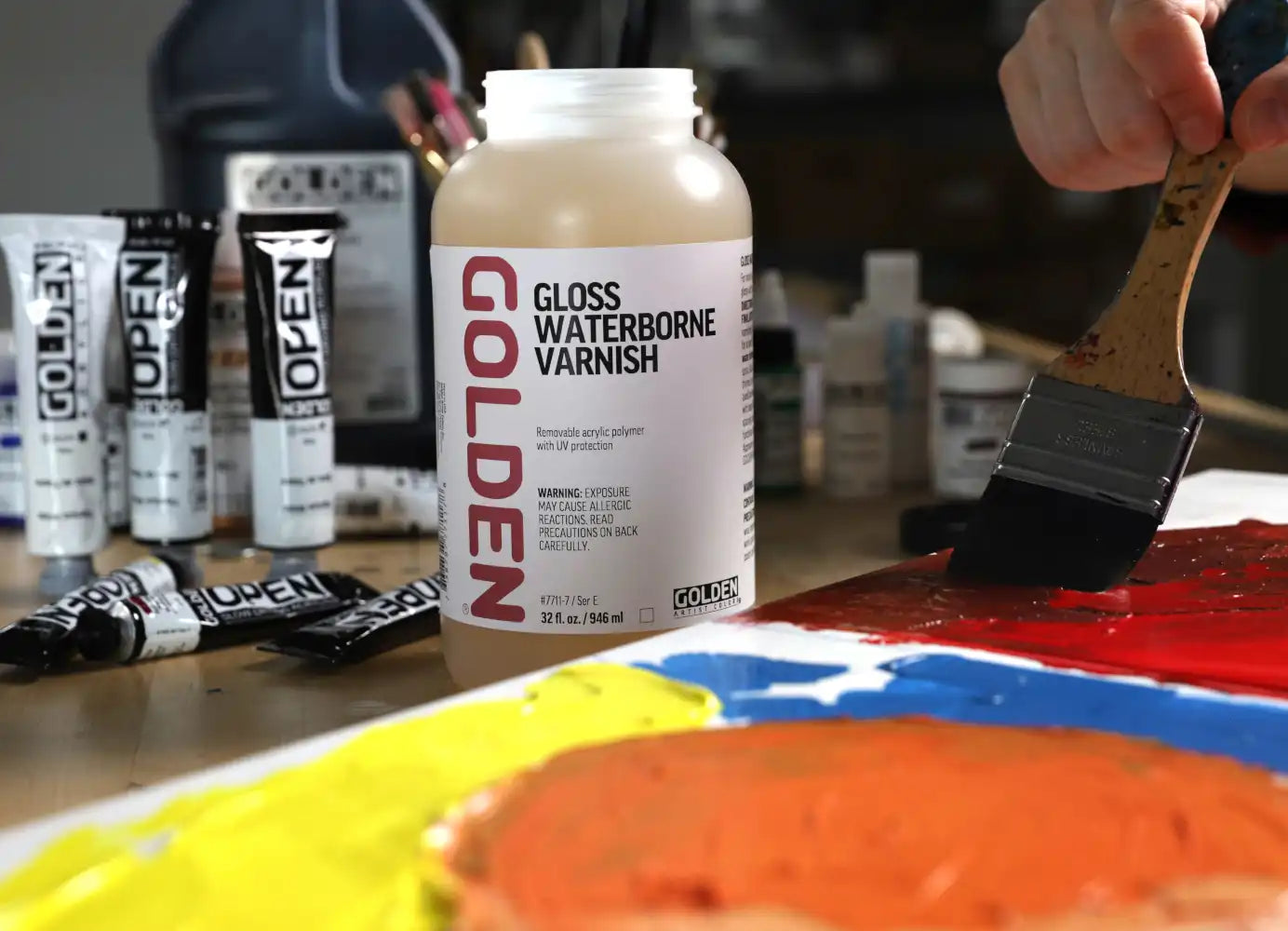Description
GOLDEN Waterborne Varnish Gloss is a water-based, removable, acrylic polymer varnish designed to protect interior acrylic paintings from dust and ultraviolet light.
Ultraviolet Light Stabilizers (UVLS) slow the rate of color change and fading in artist materials due to ultraviolet light.
Waterborne Varnish is removable for future conservation efforts. Household-strength ammonia, is used to remove Waterborne Varnish with minimal concerns of damaging the underlying artwork.
An isolation coat between the acrylic paints and varnish is recommended to reduce interaction during varnish application or removal.
Waterborne Varnish is not intended to be used on oil paintings or any artwork intended for outdoor display.
Waterborne Varnish is not intended for use on functional objects (such as furniture).
Painting with acrylics or oils onto Waterborne Varnish is not recommended.
PRODUCT DIRECTIONS
To increase the chances of a successful application, we strongly suggest practicing with the products and techniques on test paintings, before applying the varnish onto actual artwork.
An Isolation Coat is highly encouraged before varnishing to reduce potential interaction with susceptible painting materials. Contact GOLDEN Artist Colors if there are any questions.
Mix varnish fresh for each application; do not store mixed product.
Estimate around 100 square feet coverage for every quart (32oz) of thinned Waterborne Varnish.
THINNING, MIXING AND APPLYING VARNISH
Allow acrylics to fully dry for at least 72 hours prior to applying the GOLDEN Waterborne Varnish. The use of Retarder or Glazing Liquid may require a longer waiting period.
If GOLDEN OPEN Acrylic Paints, Gels or Mediums were used during the painting process, please visit the OPEN Product Information Sheet and follow the recommended timeframe between layers of OPEN Acrylics, Isolation Coats, and Varnish.
Pour some varnish into a (ideally clear) container. Leave enough space to allow for water additions.
After each use, wipe the cap and container threads to remove any varnish before replacing the lid. This will help prevent dried bits of varnish from falling into the container when you next open the container. Dried bits will need to be strained from the varnish before use.
Thin Waterborne Varnish with water prior to application.
Brushing: Start at a 4:1 ratio (Varnish to Water), and adjust as necessary.
Spraying: Start at a 2:1 ratio (Varnish to Water), and adjust as necessary.
Brush-Application Process
- Paint rollers or foam brushes are not recommended for use with Isolation Coat or Waterborne Varnish.
- In order to apply the varnish quickly and evenly, use a wide, thin, synthetic wash brush. This type of brush allows for uniform application before the varnish begins to set up.
- Begin applying the varnish onto the painting surface. It can be applied onto a horizontal or vertical surface.
- While it is important to not overload the varnish amount onto a painting, it is also important to apply enough varnish for brush-strokes and bubbles to dissipate.
- Apply the varnish carefully but quickly, brushing towards the edge but not past.
- After the varnish covers the entire painting (except near the edge), brush from the painting edge inward into the wet product.
- Repeat this process and work around the entire perimeter until you cover the painting completely with varnish.
- Finally, smooth out the varnish, assuring it covers the entire painting evenly without any missed spots or puddling, runs, or sags.
- Avoid overworking the varnish and finish applying before the varnish begins to dry. Once the varnish begins to feel tacky, stop brushing to allow it time to relax.
- Allow 24 hours or more for the varnish to dry, unless studio conditions allow for faster re-application. After 24 hours, assess the varnish surface.
- If the dried varnish layer is not satisfactory, wait 24 hours and apply another layer to even the varnish surface.
- Allow 7 days drying before packing, shipping, or framing the artwork.
- Ideally, store and ship artwork assuring nothing is making contact with the varnish surface.
MULTIPLE VARNISH LAYERS
Ideally, only one layer of GOLDEN Waterborne Varnish over an Isolation Coat layer sufficiently creates a uniform surface. Always allow at least 24 hours between coats of varnish to reduce the chance of reactivating the underlying layer.
VARNISH REMOVAL
Removing GOLDEN Waterborne Varnish may be required if the varnish application isn’t satisfactory, or there is damage that occurs to the varnish surface. A cured acrylic painting, with an Isolation Coat under the varnish, is the optimal candidate for varnish removal as there is much less chance of an issue during removal.
NOTE: Practice and Test Varnish Removal on unimportant acrylic surfaces.
If you are NOT the artist of a painting that requires conservation procedures, contact a local conservator as varnish removal can permanently damage artwork.
If at any point you have concerns or issues during removal, stop the process immediately and let it dry. Take photos of the issue and contact the Material Specialists at help@goldenpaints.com
CARE AND CLEANING
GOLDEN Waterborne Varnish is intended to protect an acrylic painting for many decades, until such time as it becomes too soiled that regular cleaning cannot remedy. Please refer to the Just Paint Article “Techniques for Cleaning Acrylic Paintings” for detailed instructions on the safest way to help keep the painting looking its best.
DRY VARNISH SURFACE PROPERTIES
Caution should be used whenever handling varnished artwork.
- Allow one week after last varnish coat before handling/packing/shipping.
- Avoid stacking of artwork and any direct contact with any materials during shipping or storage.
- Visit our Pack and Ship Landing Page for best practices for storage and shipping paintings.
TECHNICAL DATA
|
Waterborne Varnish Product Properties |
|
|
Binder Composition |
Acrylic copolymer MMA/BA |
|
MFFT (Minimum Film Formation Temp.) |
49° F (9.5°C) |
|
Tg (Film Hardness) |
21°C / 70F |
|
pH Range |
8.5-9.0 |
|
Coverage |
100 ft.2/qt. (9 m2/L) |
|
Thinner/Solvent |
Distilled Water |
|
Removal |
Household, Clear Ammonia |
|
Cleanup |
Warm, soapy water |
Disclaimer
The above information is based on research and testing done by Golden Artist Colors, Inc., and is provided as a basis for understanding the potential uses of the products mentioned. Due to the numerous variables in methods, materials and conditions of producing art, Golden Artist Colors, Inc. cannot be sure the product will be right for you. Therefore, we urge product users to test each application to ensure all individual project requirements are met. While we believe the above information is accurate, WE MAKE NO EXPRESS OR IMPLIED WARRANTIES OF MERCHANTABILITY OR FITNESS FOR A PARTICULAR PURPOSE, and we shall in no event be liable for any damages (indirect, consequential, or otherwise) that may occur as a result of a product application.


